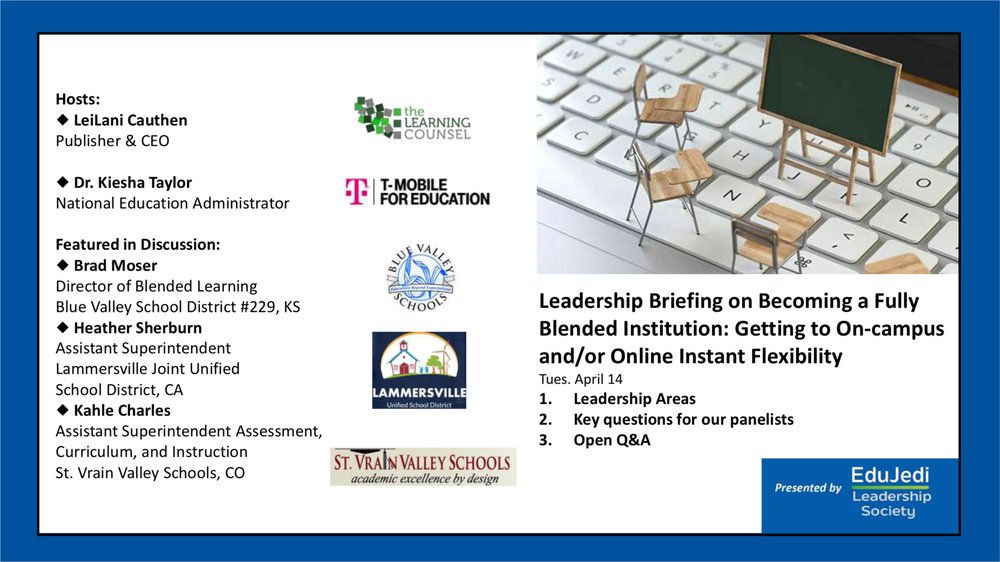There has never been a more urgent time for learning institutions to transition to a fully-blended model, with the ability to instantly change from an on-campus to an online trajectory. In this Learning Counsel Emergency Nation Virtual Discussion, some of America’s top education leaders share how they are getting there.
According to Dr, Kiesha Taylor, National Education Administrator for T-Mobile, “What we've seen happening over the last month and a half, we’ve had to increase ourselves from serving 250,000 students over two and a half years to now an additional 600,000 students over the last six weeks. And some of that just comes from strategic conversations, and school districts saying, ‘Hey, we can do all the instructional planning last minute that we need to and we can try and bridge this digital divide as much as we can.’
“But the biggest thing is the access. We can train our teachers we can even get students ready. I was on a call earlier this morning. We talked a little bit about short term versus long term assessment of student needs. The conversation really shifts us back to what does empirical research tell us. It tells us that students that have connectivity perform better academically. Students who have connectivity will have a higher percentage of attendance and student engagement and motivation. There are so many impacts, but now it even goes deeper, because kids don't have the access. What's the number one way that we know if students are okay in the classroom? We set our eyes on them. So, I think now we're looking into bridging the digital divide for several different reasons, and to make sure that we're keeping children safe and we're connecting them to the outside world.
“It's really about access and academics. We know that there is a major shift that has happened. And so the real goal is to shift from response based planning to long term strategic planning. And what does that really mean? Defining what that means and having the opportunity to say, we want to make sure that we're defining partnerships with vendors and companies that are making accessibility possible.”
To make the shift to long term strategic planning, there are many questions to consider. According to LeiLani Cauthen, CEO and Publisher at the Learning Counsel, some of those questions include, “What does your infrastructure really look like? What are you doing with equity of access? Your hardware, your power access, those are big deals. What are you doing with your systems and data entry right now? Are you expecting all the same data entry coming in from teachers? What do you have for courseware content, learning games? What are you doing with integration and are you paying attention to student data, privacy and security?”
Brad Moser is the Director of Blended Learning at Blue Valley School District #229. He cautions us to take a step back and not to overwhelm our teachers and students during this time of transition. “I appreciate in Blue Valley, we've taken a stance to help our teachers to stop and just breath,” said Moser. “We've been practicing and preaching SEL for a long time. Now is the time to actually just do it. From the top down, Dr Merrigan and Dr. White, our superintendents, have modeled this and have said this over and over again to pause and breathe and take time to take care of yourself. And I hope our parents and families are hearing this message as well. Pause for a moment and take care of yourself, before trying to over-schedule our learning throughout this. We've tried to take the keep it simple, less is more approach.”
Heather Sherburn is the Assistant Superintendent at Lammersville Joint Unified School District. According to Sherburn, “Our definition of distance learning is a blend of using digital and non-digital instructional things. Making your assignments look different so that they fit into the family lifestyle. They could learn to demonstrate mastery of standards by having conversations with parents, by going outside and exploring something, by doing a video and uploading it. It didn't need to be the same way we might have been doing it if this were regular schooling. So, we encourage a lot of things like that.”
Kahle Charles, Assistant Superintendent Curriculum and Instruction at St. Vrain Valley Schools, shared thoughts about blended learning and its application in online instruction. “We've been going on the blended learning model for about seven years now,” said Charles. “One of the things, that really stuck with me, I had the opportunity to visit with Catlin Tucker and she told me, ‘Kahle, to be superior to the traditional teaching model. blended learning must engage students and provide interactions that exceed those possible in the physical environment.’ And if you think about that idea and what you're trying to create, the possibilities are just amazing. And certainly in our, our current situation, I've had several teaching staffs reach out to me and say thank you for the training they received in blended learning, because it's made the transition to distance learning in this online environment so much better for us.
“And those teachers we've trained now become the leads in those buildings to really make this a better transition, not only for them but for their students and parents at home as well. Communication is key. We need to keep communicating these things. I know there's a heavy lift when you start blended learning, but overall it will save the teacher time. And I think of those elementary teachers who are always cutting and copying and stapling and collating things, once they've got some that really good online content loaded into whatever your learning management system, it actually is going to save them time to do what they are really good at. That is instruction and that is sparking curiosity in our students. I'd rather have the arts teachers doing that than spending time in a work room.”
Watch the video
This important virtual discussion covered many bases and offered specifics in using a blended model. The education leaders in this discussion are among the best in America, and their programs excel in offering digital learning. As you continue your transition into online learning, you find exceptional strategies in this discussion that are working now and will continue to work for you in your own district.











